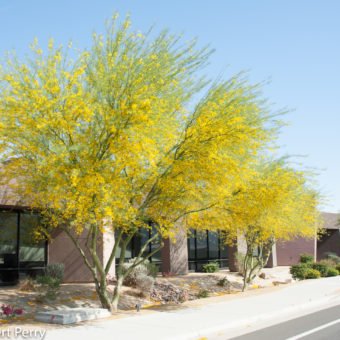
Desert Museum palo verde
Plant Type: Tree, Native
Water Needs: Low 2
Exposure: All day sun
Height: 20 ft. - 30 ft. Width: 20 ft. - 25 ft.
The Colorful Desert Garden design provides the full beauty of a dry landscape, from the sculptural shapes of succulents to the gorgeous and long-flowering color of our favorite desert shrubs and trees. While our area of inland southern California is not naturally a desert climate (it is a semi-arid Mediterranean climate), many people like both the look and the very low water demand of this style of landscaping. Additionally, this plant list works very well for extremely hot microclimates, like parking lots or west-facing areas of the garden that may experience reflected heat from driveways and cinderblock, brick, or stucco walls. The plants in this palette can take the heat while serving up beautiful blooms loved by hummingbirds as well as a variety of other birds and pollinators.
The combination of succulents and colorful desert shrubs and trees truly enhances the look of a desert garden. The contrast between these plant types enhances the visual impact of each other, resulting in a far more balanced look than a garden solely focused on succulent plants.
The succulent plants we have included here were included primarily because they are beautiful, easy to grow, and widely available. However, there are many other options available, especially at nurseries that focus on waterwise plants. Most succulents and cacti have very similar care and irrigation requirements in the garden, so feel free to do some research about other options available at the nurseries you visit and mix in additional succulents as desired.
This plant palette is available as an option for the Waterwise Community Center's Landscape Design Assistance Program. Visit cbwcd.org/desgin for more details.